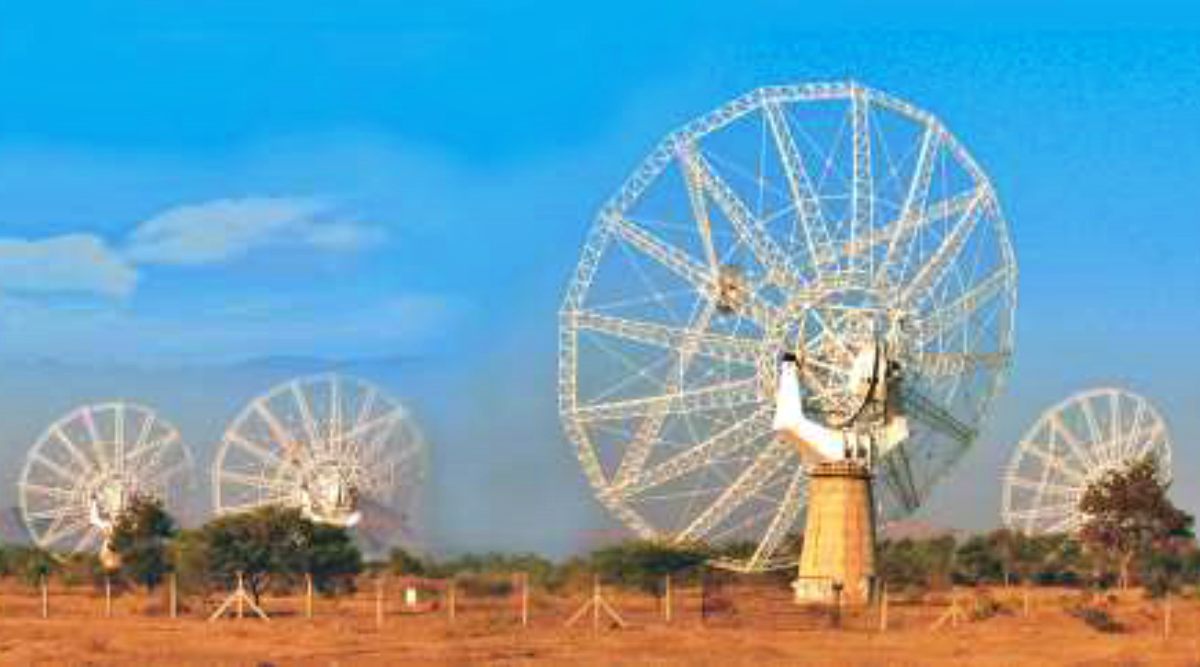 GMRT is located about 80kms from Pune city. (Express photo)
GMRT is located about 80kms from Pune city. (Express photo) A group of astronomers from Pune has obtained the first ever evidence of a galaxy merger that hosted a Fast Radio Burst (FRB) using the Giant Metrewave Radio Telescope (GMRT).
Fast Radio Bursts are extremely bright radio pulses flashing from any direction of the sky for less than a few milliseconds, and thus extremely difficult to detect. World over, astronomers are unsure about the source that produces FRBs. For this, studies are currently on about gaseous matter and stars from the nearby galaxies hosting FRBs.
Nearly 1,000 FRBs have been identified since their first detection some 15 years ago. Emerging from far away, some FRBs can either be a one-event flash or with definitive periodicity known as repeater FRBs.
Researchers from TIFR – National Centre for Radio Astrophysics (NCRA), Pune and University of California chose a relatively closer galaxy that hosted the FRB identified as FRB20180916B. It emitted radio pulses once every 16 days and was located on the outskirts of a galaxy located about half a billion light years away. The Canadian Hydrogen Intensity Mapping experiment (CHIME), responsible for detecting nearly 800 FRBs, traced FRB20180916B.
The researchers studied the 21cm line of the atomic hydrogen readings obtained using GMRT at 1420 Mhz to map the distribution of the gas in the FRB host galaxy.
While optical images of this galaxy did not divulge much interesting information, the bigger revelation came from the subsequent radio imaging and mapping of the atomic hydrogen gas from the host galaxy.
Researchers said the galaxy under study possessed 20 times less number of stars but just two times less atomic hydrogen than our Milky Way. Theoretically, a galaxy with high atomic hydrogen gas — the driver fuel for star birth — is expected to have an active star formation rate.
“The atomic hydrogen gas contained by the host galaxy was found to be ten times more than the nearby galaxies. But despite such large atomic hydrogen gas, the number of stars were relatively fewer. It thus indicates that the surplus hydrogen gas was recently acquired after a possible merger between two galaxies,” said Balpreet Kaur, a fourth year PhD student at NCRA and the lead author of the study published in the Astrophysical Journal Letters.
Due to the recent merger of the two galaxies, the atomic hydrogen gas could have been compressed. The scientists believe that the progenitor of FRB20180916B is most probably a massive star formed due to the recent merger event.
Notably, this is the first time that astronomers studying FRBs performed radio imaging of atomic hydrogen gas.
Importantly, the detection of the galaxy merger would not have not been possible without the NCRA-operated GMRT, whose 30 steerable antennas were effectively combined to track the FRB host galaxy.
“We could use different combinations of GMRT antennas that enabled us to map the atomic hydrogen within the FRB host galaxy and at the same time, trace hydrogen in the nearby companion galaxy,” said Professor Nissim Kanekar, senior NCRA researcher who was part of the study.
Most of the FRBs, Kanekar said, are located at significantly large distances away and studying similar FRB host galaxies are planned in near future.
- The Indian Express website has been rated GREEN for its credibility and trustworthiness by Newsguard, a global service that rates news sources for their journalistic standards.

